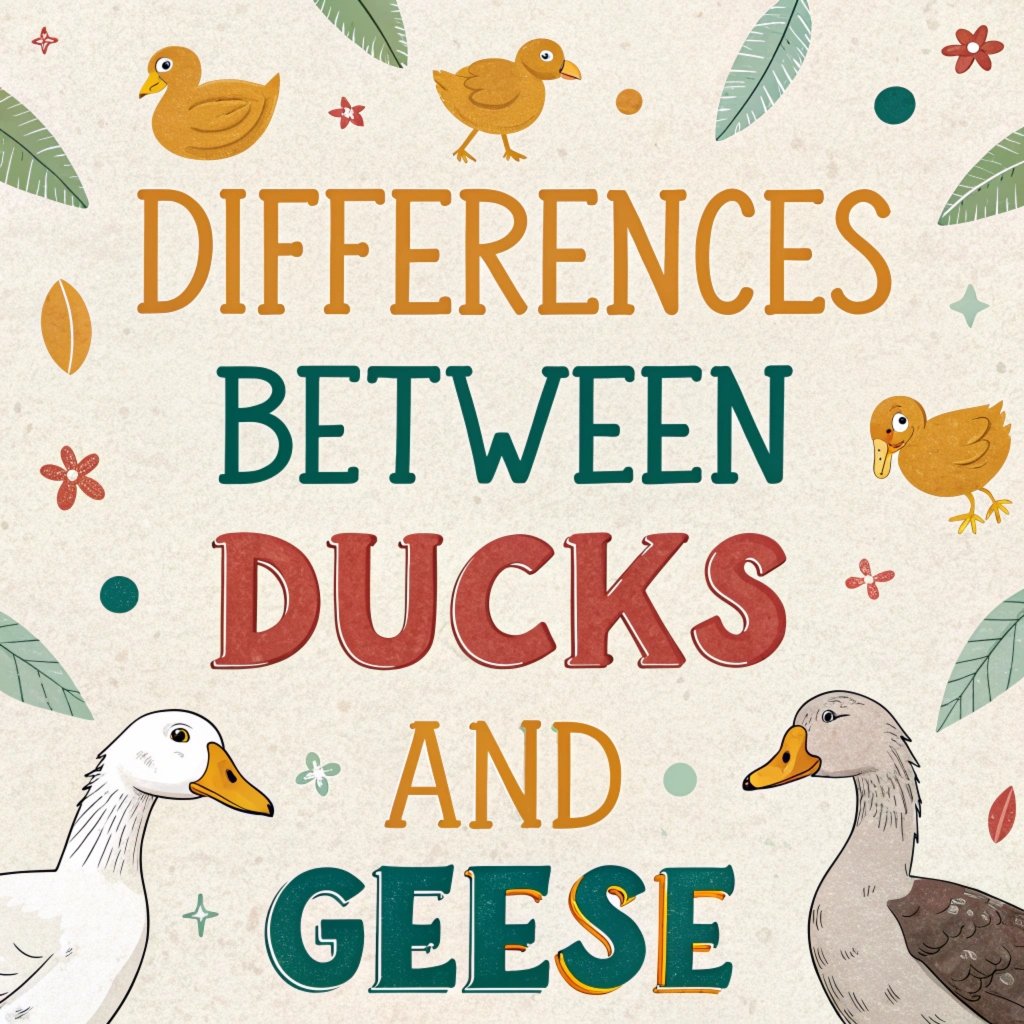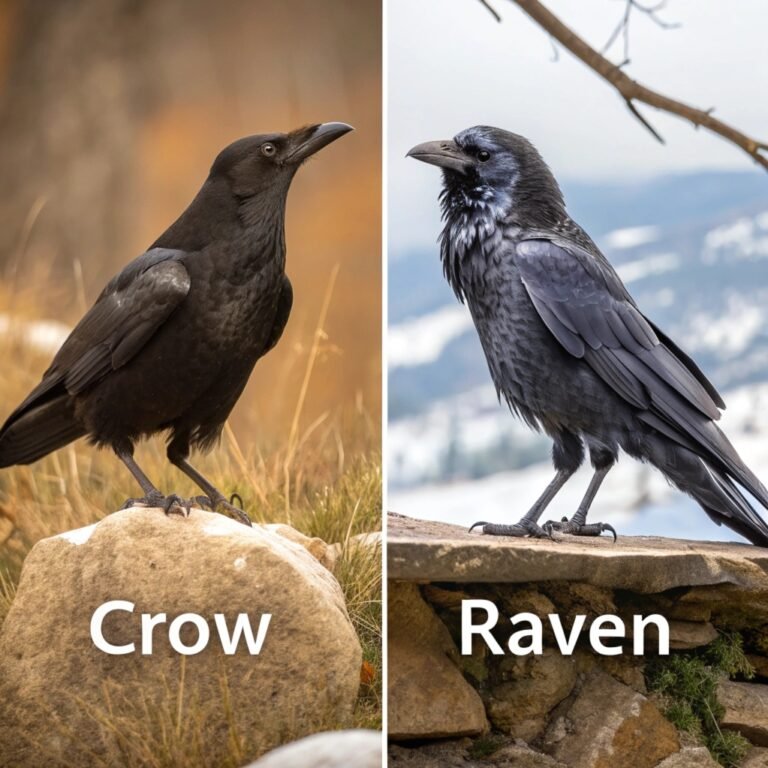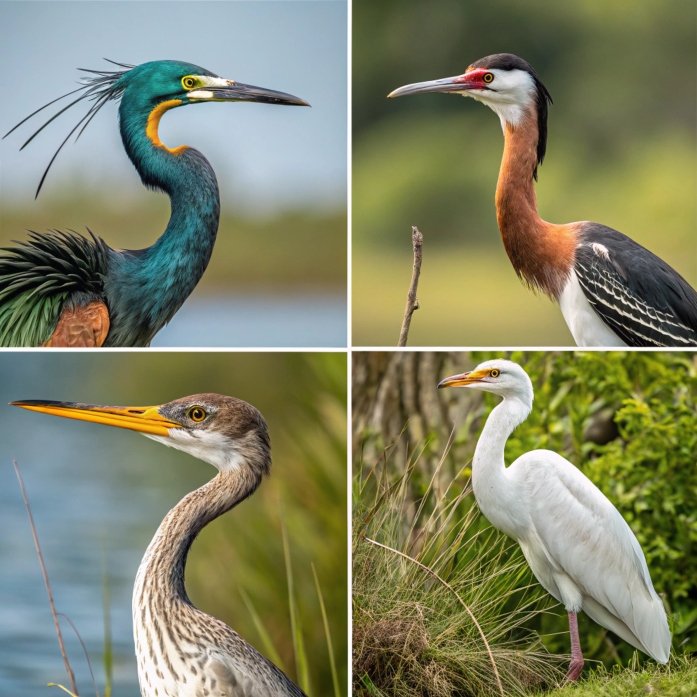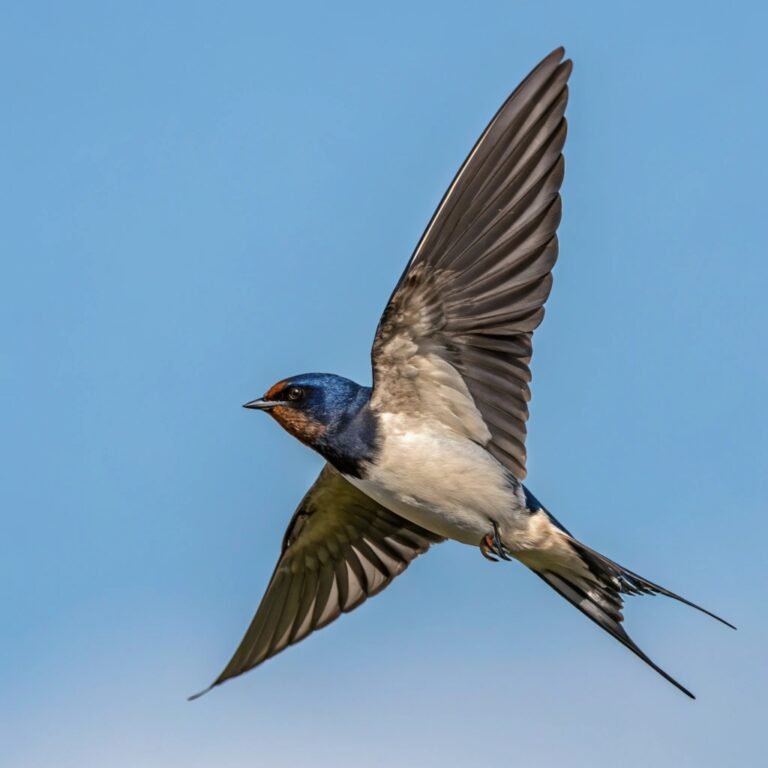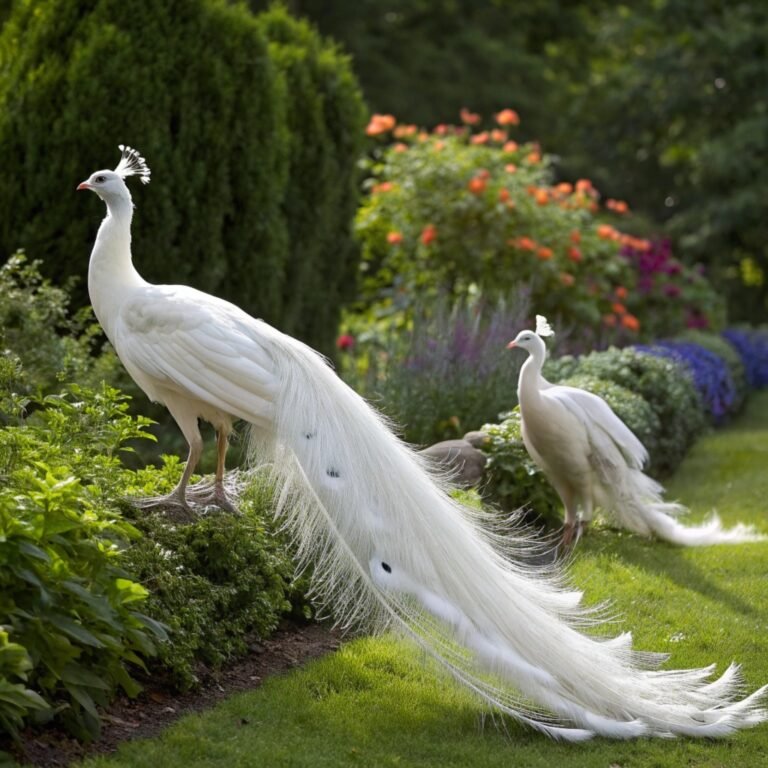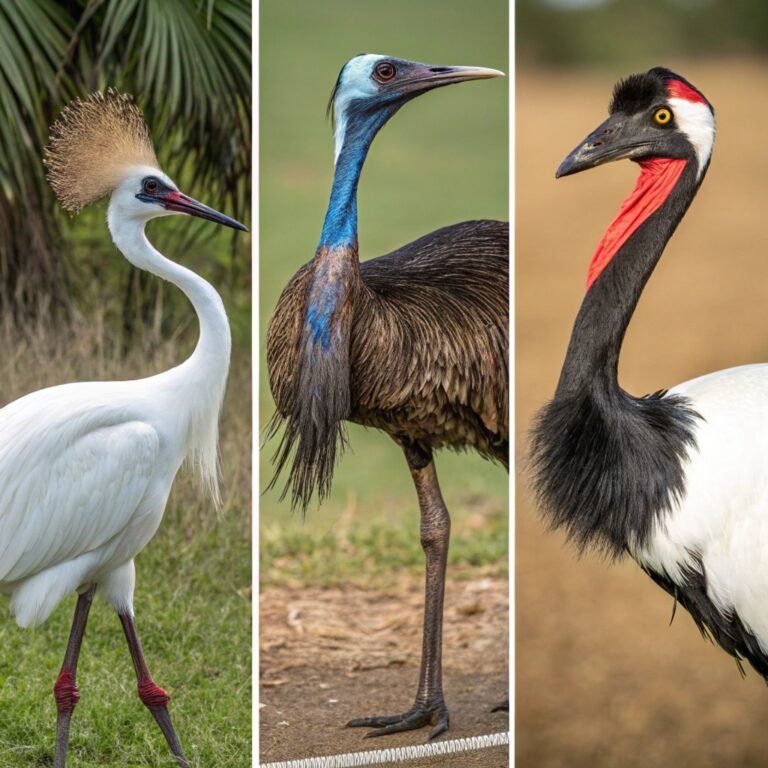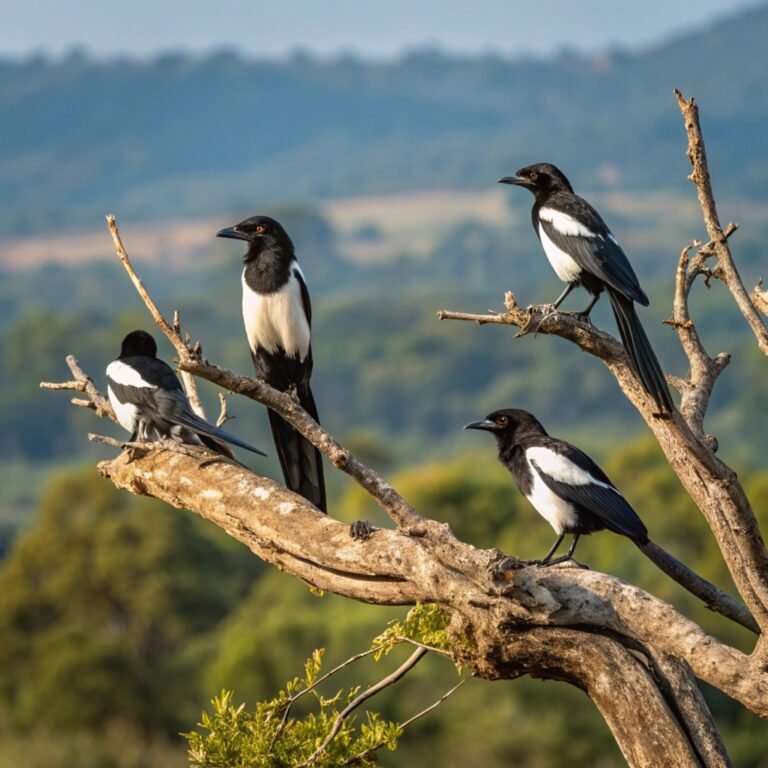Differences Between Ducks and Geese: A Comprehensive Guide
Ducks and geese, both members of the Anatidae family, are familiar waterfowl that grace our ponds, lakes, and rivers.
While they may seem similar at first glance, these birds have distinct characteristics that set them apart.
This comprehensive guide will delve into the fascinating differences between ducks and geese, exploring their physical attributes, behaviors, and lifestyles.
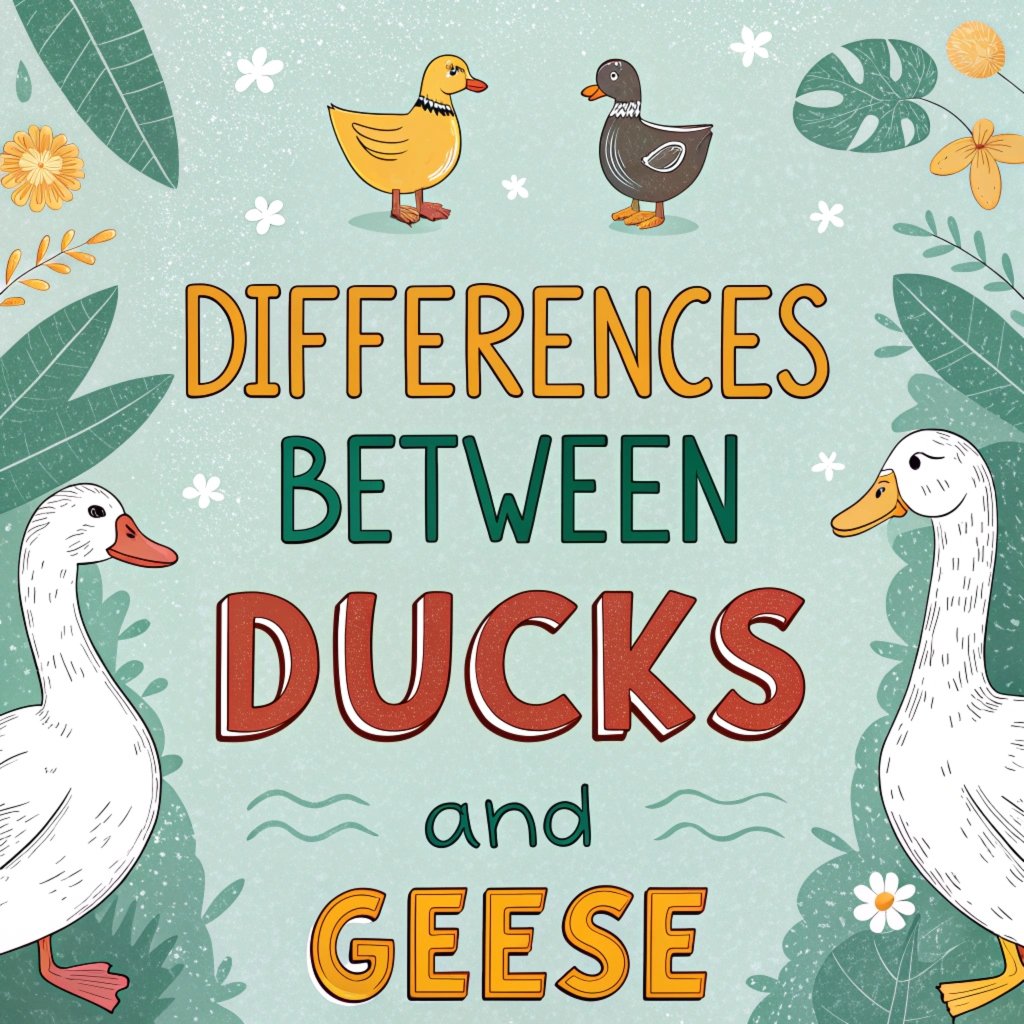
Key Takeaways:
- Ducks and geese belong to the same family but differ in size, appearance, and behavior
- Geese are generally larger with longer necks, while ducks are smaller with more colorful plumage
- Ducks have 16 or fewer neck bones, while geese have 17-24 neck bones
- Geese are herbivores, while ducks are omnivores
- Geese form lifelong pair bonds, while ducks typically mate for a single season
- Geese are more aggressive and protective of their young compared to ducks
- Ducks have a shorter lifespan (3-8 years) compared to geese (8-12 years)
- Both species are migratory, but not all duck species migrate
- Ducks quack, while geese honk
- Geese have stronger family bonds and both parents care for offspring, unlike ducks
Size and Weight: The Big Difference
One of the most noticeable differences between ducks and geese lies in their size and weight. Geese are significantly larger than their duck counterparts, with a more imposing presence.
The average duck typically weighs between 2 to 5 pounds and measures about 15 to 25 inches in length. In contrast, geese can weigh anywhere from 10 to 20 pounds and reach lengths of 30 to 50 inches.
This size difference is particularly evident when comparing common species. For instance, the Mallard duck, one of the most recognizable duck species, weighs around 1 to 3 pounds and is 20-26 inches long.
On the other hand, the Canada Goose, a well-known goose species, can weigh between 6.6 and 19.8 pounds and reach lengths of up to 43 inches.
The substantial size difference between ducks and geese is not just a matter of appearance but also influences their behavior, habitat preferences, and survival strategies in the wild.
Neck Length and Bone Structure: A Defining Feature
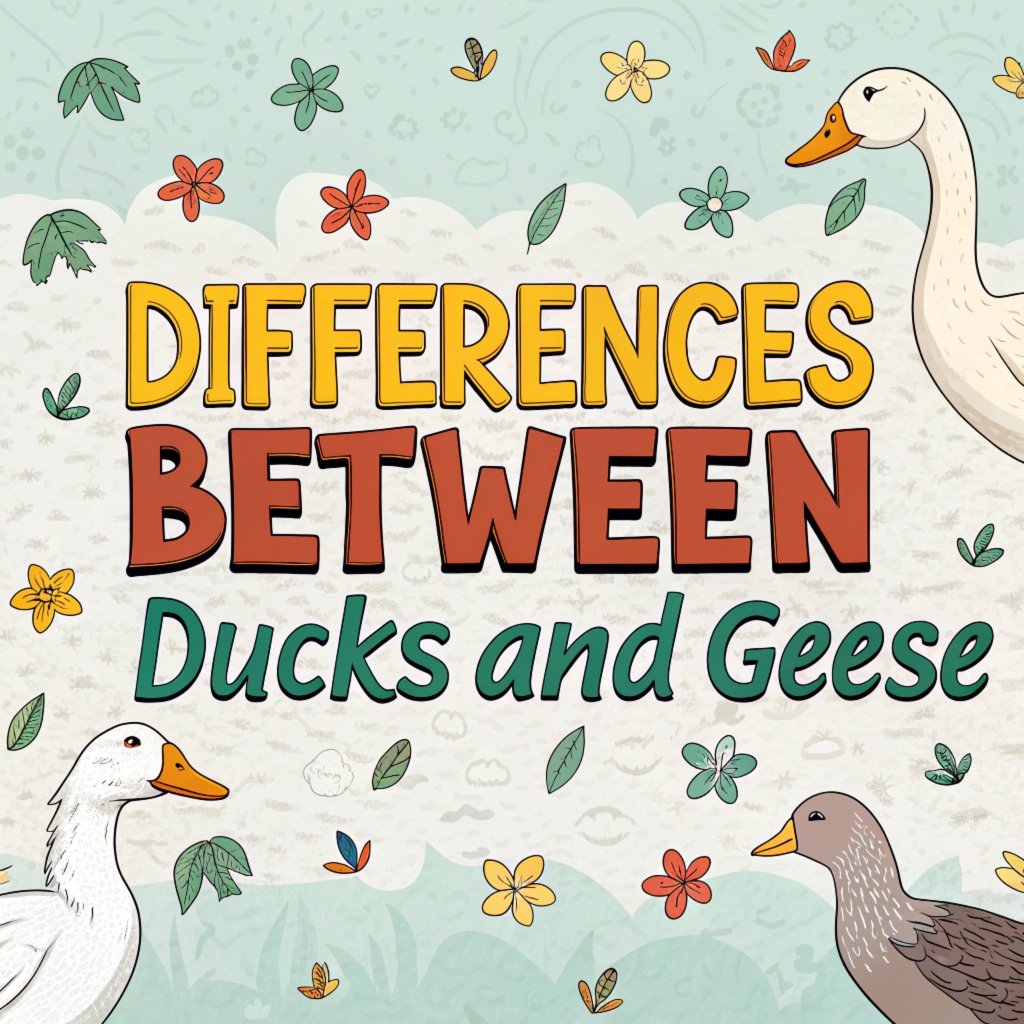
The neck length and bone structure of ducks and geese serve as a key distinguishing feature between these two waterfowl.
Geese are characterized by their long, elegant necks, which contribute to their overall larger size and more imposing presence. In contrast, ducks have noticeably shorter and more compact necks.
This difference in neck length is not just a superficial one; it’s rooted in their skeletal structure. Ducks have 16 or fewer bones in their necks, while geese possess between 17 and 24 neck bones.
This additional bone count allows geese to have greater flexibility and reach, which is particularly useful for their feeding habits and defensive behaviors.
The longer necks of geese enable them to reach underwater vegetation more easily and provide a better vantage point for spotting potential predators.
For ducks, their shorter necks are well-suited to their dabbling feeding style, where they tip forward in the water to feed on aquatic plants and small organisms.
Plumage and Coloration: Nature’s Palette
The plumage and coloration of ducks and geese offer another striking contrast between these two types of waterfowl.
Ducks, particularly male ducks (drakes), are known for their vibrant and colorful feathers. Many duck species display intricate patterns and iridescent hues, especially during the breeding season.
For example, the male Mallard duck boasts a distinctive green head, white neck ring, and blue-tinged wing feathers.
This colorful plumage plays a crucial role in attracting mates and is a prime example of sexual dimorphism in ducks.
In contrast, geese tend to have more subdued and uniform coloration. Their feathers are typically found in shades of gray, white, or brown, with less variation between males and females.
This more muted appearance helps geese blend into their surroundings, providing camouflage against predators.
The difference in plumage coloration reflects the distinct mating strategies and habitats of ducks and geese, showcasing nature’s adaptation to different ecological niches.
Bill Shape and Feeding Habits: Adapted for Survival
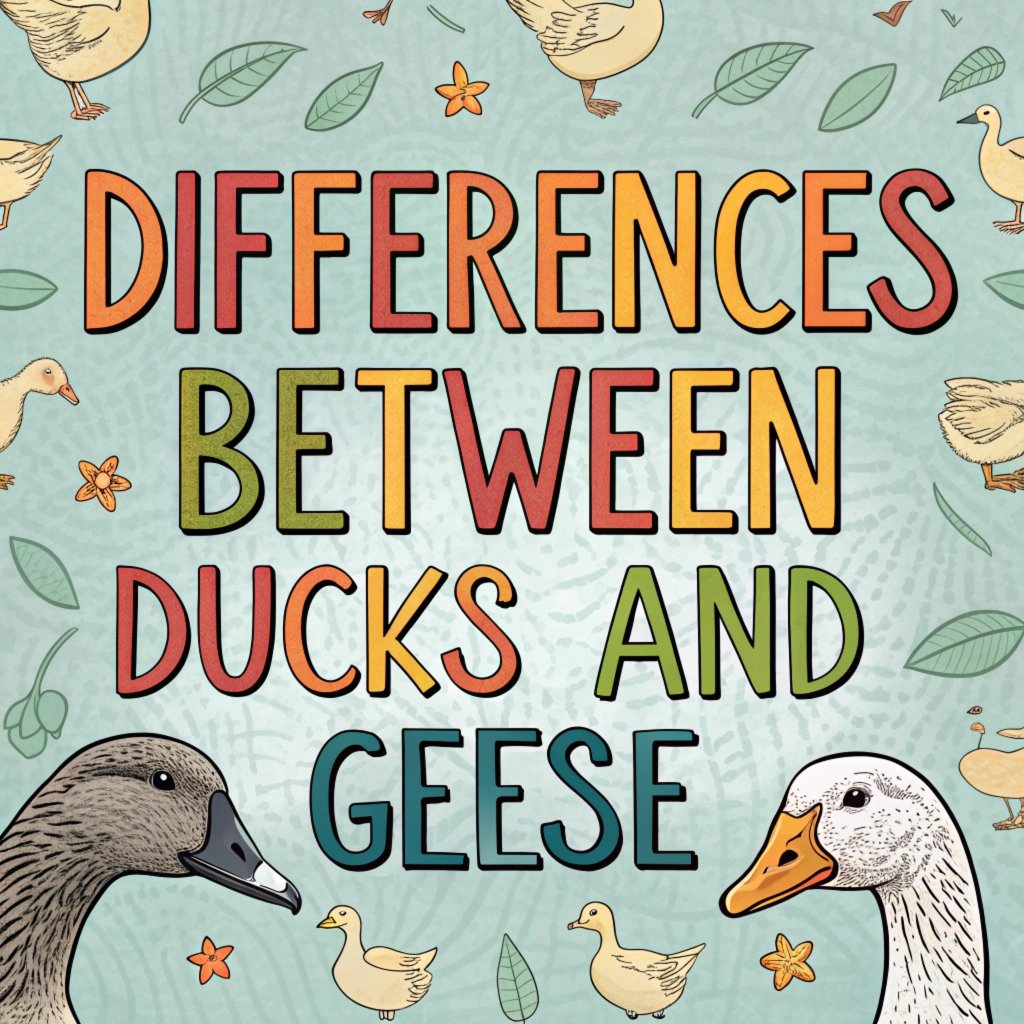
The bill shape of ducks and geese is another distinguishing feature that reflects their different feeding habits and dietary preferences. Ducks typically have broad, flat bills with tiny serrations along the edges.
This unique bill structure serves as an efficient filtering system, allowing ducks to strain water and extract small aquatic plants, insects, crustaceans, and fish.
Many duck species are omnivorous, with a diet that includes both plant matter and small animals. Their bills are perfectly adapted for this varied diet, enabling them to forage in shallow waters and muddy areas.
Geese, on the other hand, have shorter, more pointed bills that are well-suited for their primarily herbivorous diet. Their bills are designed for grazing on grass and other vegetation, both on land and in shallow water.
The shape of a goose’s bill allows it to efficiently pluck and eat aquatic plants and terrestrial vegetation.
This difference in bill shape and feeding habits influences the habitats these birds prefer and their role in various ecosystems.
Foot Structure and Swimming Abilities: Webbed Wonders
Both ducks and geese possess webbed feet, a characteristic feature of waterfowl that enables them to navigate aquatic environments with ease. However, there are subtle differences in their foot structure that reflect their specific adaptations.
Ducks have well-developed webbing between their toes, which makes them excellent swimmers. Their webbed feet act like paddles, propelling them through water effortlessly.
This adaptation is crucial for their semi-aquatic lifestyle, allowing them to dive for food and escape predators quickly.
Geese also have webbed feet, but their webbing is often more prominent, with large webbed toes ending in short toenails.
While geese are strong swimmers, their feet are also adapted for walking on land. Geese have slightly taller legs in proportion to their bodies compared to ducks, which aids in their grazing habits on land.
These differences in foot structure reflect the varied lifestyles of ducks and geese, with ducks being more aquatic and geese dividing their time between water and land.
Mating and Breeding Behaviors: Love and Family Life
The mating and breeding behaviors of ducks and geese showcase interesting differences in their social structures and parental care. Geese are known for their strong, lifelong pair bonds.
Once a pair of geese mate, they typically remain together for life, reuniting each year during the breeding season. This monogamous behavior contributes to their reputation for loyalty and family-oriented nature.
Ducks, in contrast, generally form seasonal pair bonds. They mate for a single breeding season and often seek new partners in subsequent years.
This difference in mating strategy influences their breeding behaviors and parental care.
In terms of offspring care, geese demonstrate remarkable dedication. Both male and female geese actively participate in raising their young, known as goslings.
They fiercely protect their nests and offspring, often displaying aggressive behavior towards potential threats.
Ducks, however, show a different parental care pattern. Female ducks typically bear the primary responsibility for caring for ducklings. It’s common to see a mother duck leading a line of ducklings, providing protection, warmth, and guidance.
Lifespan and Survival Strategies: Longevity in the Wild
The lifespan of ducks and geese differs significantly, reflecting their size, behavior, and survival strategies. In the wild, ducks generally have a shorter lifespan, typically ranging from 3 to 8 years.
This shorter life expectancy is partly due to their smaller size and less aggressive nature, which makes them more vulnerable to predators.
Geese, on the other hand, tend to have a longer lifespan, often living 8 to 12 years in the wild, with some individuals surviving even longer. Their larger size, more aggressive behavior, and strong family bonds contribute to their longevity.
The survival strategies of these birds also differ. Ducks often rely on their ability to fly quickly and their more cryptic coloration (especially females) to avoid predators. Many duckling species don’t survive their first year due to predation.
Geese employ a more aggressive approach to survival. They are known for their protective behavior, especially when guarding their nests and young.
Their larger size and tendency to flock in large groups also serve as deterrents to potential predators.
Vocalization and Communication: Quacks vs. Honks
The vocalizations of ducks and geese are distinctly different and serve various purposes in their respective social structures.
Ducks are famous for their quacking sounds, although not all duck species quack. The familiar “quack” is most associated with female Mallard ducks, while males often make a softer, rasping sound.
Geese, in contrast, are known for their loud honking calls. These vocalizations are used for various purposes, including communication within the flock, warning of potential dangers, and during migration to maintain flock cohesion.
Both ducks and geese use their vocalizations to find food sources, signal danger, and attract mates.
However, the volume and carrying power of goose calls are generally greater than those of ducks, reflecting their larger size and more social nature.
In addition to vocal communication, both species use visual signals. Geese may use wing and body movements to signal aggression, while male ducks often use their colorful plumage in courtship displays.
Migration Patterns: Seasonal Journeys
Both ducks and geese are known for their migratory behavior, but there are differences in their migration patterns and the extent of their journeys.
Geese are famous for their long-distance migrations, often traveling thousands of miles between their breeding and wintering grounds. The V-formation flight of geese is an iconic image of bird migration.
Most goose species are obligate migrants, meaning they must migrate to survive. They typically breed in the Arctic regions and fly south for the winter, covering vast distances in the process.
Duck migration patterns are more varied. While many duck species do migrate, not all of them do. Some duck species are partial migrants, with some populations migrating while others remain in the same area year-round.
The distance of duck migrations can also vary greatly depending on the species and the availability of suitable habitats.
Ducks that do migrate often follow similar routes to geese, using established flyways. However, their migrations may not be as long or as strictly timed as those of geese.
Habitat Preferences: Where They Call Home
The habitat preferences of ducks and geese, while overlapping in many areas, show some distinct differences that reflect their feeding habits and lifestyles.
Ducks are highly adaptable and can be found in a wide range of aquatic environments. They prefer shallow water bodies such as ponds, marshes, slow-moving rivers, and the edges of lakes.
Many duck species are comfortable in both freshwater and saltwater environments. Some, like sea ducks, are specifically adapted to coastal and marine habitats.
Ducks often seek out areas with abundant aquatic vegetation and small aquatic organisms, which form a significant part of their diet.
Geese, while also aquatic birds, have a stronger affinity for grassy areas near water bodies. They are often seen grazing on land, particularly in fields, parks, and golf courses. During breeding seasons, many goose species prefer tundra or grassland habitats near water.
Both ducks and geese require access to water for feeding, resting, and escaping predators. However, geese are more likely to spend extended periods on land, especially when feeding, compared to the more aquatic lifestyle of ducks.
Social Behavior: Flocking and Family Dynamics
The social behavior of ducks and geese reveals interesting differences in their group dynamics and family structures. Both are social creatures and are often seen in groups, but the nature of these groupings differs.
Geese are known for their strong family bonds and hierarchical flock structure. A typical goose flock consists of several family units, with mated pairs and their offspring staying together for extended periods. Young geese often remain with their parents for a full year and may migrate with them.
Goose flocks have a clear social hierarchy, with dominant pairs taking leadership roles. This social structure is evident in their V-formation flights, where experienced birds take turns leading the flock.
Ducks, while also social, tend to form looser associations. Outside of the breeding season, ducks often gather in large groups called rafts, especially when resting on water. However, these groups are generally less structured than goose flocks.
During the breeding season, ducks become more solitary or form smaller groups. Unlike geese, male ducks typically do not stay with the female to help raise the ducklings.
Ecological Roles: Impact on Ecosystems
Ducks and geese play significant but somewhat different ecological roles in the environments they inhabit. Both are important components of wetland and aquatic ecosystems, but their impacts vary due to their different feeding habits and behaviors.
Ducks, with their omnivorous diet, play a crucial role in aquatic ecosystems. They help control populations of small aquatic organisms and contribute to the dispersal of aquatic plant seeds. Their feeding behavior can also help maintain the balance of nutrients in water bodies.
Geese, as primarily herbivores, have a significant impact on terrestrial vegetation. Their grazing habits can help maintain the diversity of plant species in grassland areas.
However, in some urban and agricultural settings, large populations of geese can sometimes lead to overgrazing.
Both ducks and geese serve as important prey species for various predators, contributing to the food web. Their droppings also play a role in nutrient cycling, particularly in wetland environments.
The migratory nature of both ducks and geese means they play a role in connecting different ecosystems across vast distances, contributing to the dispersal of seeds and small organisms.
FAQs
How can I tell the difference between a duck and a goose at a glance?
The easiest way to distinguish between a duck and a goose at a glance is by their size and neck length. Geese are generally larger with longer necks, while ducks are smaller with shorter, more compact necks. Additionally, geese typically have more subdued coloration, while many duck species, especially males, have vibrant and colorful plumage.
Do ducks and geese have different diets?
Yes, ducks and geese have different dietary preferences. Ducks are generally omnivorous, eating a variety of aquatic plants, insects, small fish, and crustaceans. Geese, on the other hand, are primarily herbivores, feeding on grass, aquatic plants, and sometimes grains.
Which is more aggressive, a duck or a goose?
Geese are generally more aggressive than ducks, especially when protecting their nests or offspring. Geese are known for their territorial behavior and may hiss or charge at perceived threats. Ducks are typically more docile and are more likely to flee from danger rather than confront it.
Do ducks and geese mate for life?
Geese typically mate for life, forming strong, long-term pair bonds. Ducks, however, usually form seasonal pair bonds, mating with different partners each breeding season.
Can ducks and geese interbreed?
While ducks and geese belong to the same family, they are different genera and species. Interbreeding between ducks and geese is extremely rare in the wild and generally does not produce viable offspring. However, some closely related species within the duck family or within the goose family may occasionally interbreed.
Which lives longer, ducks or geese?
Geese generally have a longer lifespan than ducks. In the wild, ducks typically live for 3-8 years, while geese can live for 8-12 years or more. The longer lifespan of geese is partly due to their larger size and more aggressive defense against predators.
Do all ducks and geese migrate?
Not all ducks and geese migrate. Most goose species are obligate migrants, meaning they must migrate to survive. However, duck migration patterns are more varied. Some duck species migrate long distances, others are partial migrants (with some populations migrating while others don’t), and some species don’t migrate at all, depending on their habitat and food availability.

Hello, I’m Emily Price, the founder of Birds Affection. As a passionate bird enthusiast and spiritual seeker, I’ve always been fascinated by the symbolic meanings and mystical connections between birds and our lives. On this website, I share my knowledge and insights on the spiritual significance of various bird species, exploring their roles as messengers, guides, and teachers. Through my writing, I aim to inspire and educate others on the profound wisdom and beauty that birds bring to our world. Join me on this journey as we delve into the enchanting realm of bird symbolism and discover the hidden meanings behind these magnificent creatures.

